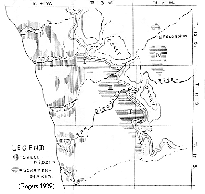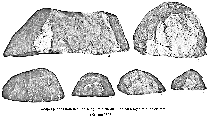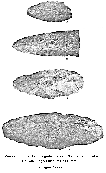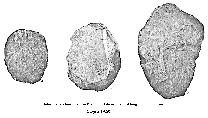San Dieguito Complex
The interpretation of the San Dieguito complex has long been a major issue in San Diego archaeology. No consensus exists as to how archaeological manifestations of the complex should be recognized and whether their distinctiveness from other remains is attributable to differences in chronology, cultural tradition, or site function. Among the extended discussions of the issue are the papers in a volume edited by Dennis R. Gallegos (1987a); an overview by Claude N. Warren, Gretchen Siegler, and Frank N. Dittmer (2008); and a volume recently published by Gallegos (2017).
 The San Dieguito complex was first recognized by Malcolm J. Rogers at site SDM-W-240 in Escondido (Rogers 1966:183-184). His initial published description, “The Stone Art of the San Dieguito Plateau” (1929), labeled the early producers of a distinct artifact pattern as the Scraper Makers. Rogers reported the presence of Scraper Maker sites along the eastern margin of San Diego’s coastal plain between Peñasquitos and San Marcos creeks, as well as farther inland in the valley of Escondido. Contrasted with this pattern to the west were coastal sites produced by the Shell Midden people (later renamed the La Jolla complex), who were initially thought to have inhabited the region prior to the Scraper Makers.
The San Dieguito complex was first recognized by Malcolm J. Rogers at site SDM-W-240 in Escondido (Rogers 1966:183-184). His initial published description, “The Stone Art of the San Dieguito Plateau” (1929), labeled the early producers of a distinct artifact pattern as the Scraper Makers. Rogers reported the presence of Scraper Maker sites along the eastern margin of San Diego’s coastal plain between Peñasquitos and San Marcos creeks, as well as farther inland in the valley of Escondido. Contrasted with this pattern to the west were coastal sites produced by the Shell Midden people (later renamed the La Jolla complex), who were initially thought to have inhabited the region prior to the Scraper Makers.
The San Dieguito complex has come to be identified in particular with the basal component of the C. W. Harris Site (CA-SDI-147) near Rancho Santa Fe. The Harris Site was initially excavated by Rogers in 1938 and subsequently by several other archaeologists, including Claude N. Warren, D. L. True, Paul Ezell, Richard Carrico, and Ted Cooley (Warren 1966, 2013; Warren and Ore 2011; Warren and True 1961). Based on radiocarbon dates, according to Warren and H. T. Ore (2013:81), “the San Dieguito occupaton at the C. W. Harris Site began sometime prior to 9,030 (11,223 to 9,322) B.P. and may have persisted to ca. 8,540 (10,561 to 8,540) B.P. Excavations at the Harris Site and the assemblages recovered have also been discussed by Sheila Vaughan (1982), Edward Knell (2010), and Warren (2013)
The geographical range proposed for the San Dieguito complex was later greatly expanded beyond western San Diego County. Rogers and other early investigators recognized similar sites in Baja California, the Colorado Desert, western Arizona, the Mojave Desert, the western Great Basin, and northern California (Haury 1950; Massey 1947; Rogers 1939, 1958, 1966; Treganza 1947). The Topanga Site in the Santa Monica Mountains was suggested as a San Dieguito site (Heizer and Lemert 1947; Treganza and Bierman 1958; Treganza and Malamud 1950), but that identification was disputed by Warren and others (Wallace 1955; Warren and True 1961; Warren et al. 2008). David A. Fredrickson and Joel W. Grossman (1977) recognized the presence of the San Dieguito complex in the San Joaquin Valley. Paul H. Ezell (1983) found San Dieguito sites in western Texas, and Julian Hayden (1987) recognized such sites in southeastern Utah, western Texas, northwestern Sonora, and even as far south as Durango and Oaxaca in southern Mexico. Cultural categories considered to coincide with or overlap San Dieguito have included the Playa culture, Lake Mohave complex, Western Pluvial Lakes tradition, and Western Lithic co-tradition.
 Several different approaches have been used to define and distinguish San Dieguito assemblages:
Several different approaches have been used to define and distinguish San Dieguito assemblages:
— Diagnostic artifact types, such as large percussion-flaked bifaces and scraper planes, have perhaps been the most common criterion. Individual artifacts appear to have been the primary basis for Rogers’s interpretation. Although at first he considered Scraper Maker, Shell Midden, and Mission Indian archaeological deposits to be spatially separate (Rogers 1929), subsequent investigations persuaded him otherwise. Of 72 sites in western San Diego County containing San Dieguito components, 64, or 89%, also had La Jolla and/or Yuman components (Rogers 1966). Because stratigraphically discrete deposits were usually absent or unrecognized, this suggests that Rogers used diagnostic artifacts rather than whole assemblages to distinguish the multiple components.
— An absence of remains that were characteristic of other periods has also been used as a criterion for recognizing San Dieguito assemblages. The absence of pottery and small projectile points distinguished San Dieguito, as well as La Jolla, assemblages from Late Prehistoric ones. To distinguish San Dieguito from La Jolla, one initial criterion used by Rogers was the prominence of shellfish remains at La Jolla sites. This criterion seems to have been generally abandoned; Warren and his collaborators (2008) also questioned the theoretical legitimacy of including “environmental elements,” such as shellfish collecting, in the definitions of cultural patterns. An absence of shell beads from San Dieguito sites was suggested as diagnostic, but that generalization was challenged by Ezell (1983). A key criterion that was long debated was the absence or scarcity of milling tools within San Dieguito assemblages. Rogers (1929, 1940) initially included milling implements, but later rejected their association. Several early investigators highlighted the lack of milling (Moratto 1984:93; Moriarty 1969; Warren 1964, 1967, 1968; Warren and True 1961). At the Rancho Park North Site, Russell L. Kaldenberg (1982; Kaldenberg and Ezell 1974) reported the absence of milling artifacts in the lower levels of the deposit, which were identified as a San Dieguito component. However, other investigators have argued that milling technology was at least present in many San Dieguito sites (Ezell 1982, 1983; Kaldenberg and Bull 1975; True 1958:262; Warren et al. 2008).
 — Another criterion that has been applied to the problem of recognizing San Dieguito components has been the overall composition of the lithic assemblage, rather than the presence or absence of individually diagnostic tool types. Rogers (1939:28, 66) at times applied such a criterion, based on the relative numerical importance of classes of flaked lithic tools (scraper planes, bifaces, plano-convex scrapers, etc.). Kaldenberg (1982; Kaldenberg and Ezell 1974) distinguished the San Dieguito component at the Rancho Park North Site from the overlying La Jolla and Late Prehistoric components on the basis of somewhat higher frequencies of artifact classes (pushplanes, choppers, blades, knives) that were also represented in the later components. Warren and his collaborators (2008) tabulated profiles for local assemblages based on the percentages of artifacts distributed within six general classes: crescents, bifaces, scrapers, hammer/choppers, cores, and manos. The first three were generally more frequent in San Dieguito assemblages, and the last three predominated in La Jolla assemblages. “Transitional San Dieguito” assemblages, presumably intermediate between San Dieguito and La Jolla, were notably inconsistent in this respect. However, no explicit criteria for differentiation San Dieguito and La Jolla were suggested.
— Another criterion that has been applied to the problem of recognizing San Dieguito components has been the overall composition of the lithic assemblage, rather than the presence or absence of individually diagnostic tool types. Rogers (1939:28, 66) at times applied such a criterion, based on the relative numerical importance of classes of flaked lithic tools (scraper planes, bifaces, plano-convex scrapers, etc.). Kaldenberg (1982; Kaldenberg and Ezell 1974) distinguished the San Dieguito component at the Rancho Park North Site from the overlying La Jolla and Late Prehistoric components on the basis of somewhat higher frequencies of artifact classes (pushplanes, choppers, blades, knives) that were also represented in the later components. Warren and his collaborators (2008) tabulated profiles for local assemblages based on the percentages of artifacts distributed within six general classes: crescents, bifaces, scrapers, hammer/choppers, cores, and manos. The first three were generally more frequent in San Dieguito assemblages, and the last three predominated in La Jolla assemblages. “Transitional San Dieguito” assemblages, presumably intermediate between San Dieguito and La Jolla, were notably inconsistent in this respect. However, no explicit criteria for differentiation San Dieguito and La Jolla were suggested.
— Differences in flaked lithic technology have been used to distinguish San Dieguito and La Jolla assemblages. A San Dieguito pattern based on a well-controlled percussion technique, some pressure flaking, and a preference for the use of fine-grained felsitic rock has been contrasted with the less well-made tools, often based on water-worn cobbles, found in La Jolla assemblages (Warren 1987; Warren and True 1961; but cf. Pigniolo 2013).
 — Similarity to a type component at the C. W. Harris Site has been proposed as the touchstone for recognizing San Dieguito assemblages, particularly by Warren (Pigniolo 2005; Warren 1966, 1967, 1984, 1987; Warren and True 1961; Warren et al. 2008). While using the Harris Site assemblage as a standard for comparison, proponents of the type approach have not made clear exactly how the comparisons should be made or what criteria of similarity ought to be used. Some investigators, including Paul H. Ezell (1987) and Charles S. Bull (1983:44), emphatically rejected the appropriateness of this use of the Harris Site, which Ezell interpreted as a special-purpose site for manufacturing flaked lithic tools. Sheila J. Vaughan (1982; Warren 1987) offered evidence challenging Ezell’s interpretation of the Harris Site as a specialized manufacturing location rather than a general habitation site.
— Similarity to a type component at the C. W. Harris Site has been proposed as the touchstone for recognizing San Dieguito assemblages, particularly by Warren (Pigniolo 2005; Warren 1966, 1967, 1984, 1987; Warren and True 1961; Warren et al. 2008). While using the Harris Site assemblage as a standard for comparison, proponents of the type approach have not made clear exactly how the comparisons should be made or what criteria of similarity ought to be used. Some investigators, including Paul H. Ezell (1987) and Charles S. Bull (1983:44), emphatically rejected the appropriateness of this use of the Harris Site, which Ezell interpreted as a special-purpose site for manufacturing flaked lithic tools. Sheila J. Vaughan (1982; Warren 1987) offered evidence challenging Ezell’s interpretation of the Harris Site as a specialized manufacturing location rather than a general habitation site.
Granting the distinctiveness of the San Dieguito complex, the question remains as to how that distinctiveness is to be interpreted:
— One interpretation is essentially chronological (e.g., Moriarty 1966). Strictly applied, the concept of a San Dieguito Period would have to encompass early assemblages that seem to be indistinguishable from subsequent middle Holocene assemblages. Few local archaeologists have been willing to go this far. Several investigators have suggested that some La Jolla sites were contemporaneous with early San Dieguito sites, and that the San Dieguito pattern may have persisted well into the middle Holocene (e.g., Gallegos 1987b).
 — Another interpretation has seen the San Dieguito complex as the product of a population belonging to a distinct cultural tradition (Warren 1967, 1968; Warren et al. 2008). Rogers envisioned the makers of the La Jolla complex as carriers of a tradition that was entirely distinct from San Dieguito: La Jollans entered the region, probably from the north, “immediately after the disappearance of the San Dieguito people” (Rogers 1945:171). On the other hand, several proponents of a Pleistocene human presence in the region have suggested that La Jolla complex assemblages predated and were contemporaneous with, as well as postdating, the San Dieguito complex (e.g., Carter 1957). James R. Moriarty (1987) saw in the San Dieguito complex a distinct tradition that had intruded into the coastal region from the interior during the terminal Pleistocene and early Holocene. In this view, San Dieguito for a time coexisted beside an earlier Pleistocene Pre-La Jolla tradition that continued into the middle Holocene as the La Jolla complex. However, Moriarty (1966, 1967) also noted a “transitional” phase between San Dieguito and La Jolla. Alternatively, Brian F. Smith (1987b) suggested that pre-La Jolla, San Dieguito, and La Jolla each represented a separate tradition, and that regional prehistory was punctuated by two intrusions: first by the San Dieguito complex from the east during the terminal Pleistocene, and then by the La Jolla complex from the north during the early Holocene. Russell Kaldenberg (1982) suggested that the San Dieguito tradition had gradually turned into the La Jolla tradition. Warren and his collaborators (2008) distinguished a “Transitional San Dieguito” pattern apparently spanning their Initial (ca. 8500-6200 B.C.), Transitional (ca. 6200-5200 B.C.), and Middle Archaic (ca. 5200-2000 B.C.) Periods, which suggests a developmental continuity between the San Dieguito and La Jolla complexes.
— Another interpretation has seen the San Dieguito complex as the product of a population belonging to a distinct cultural tradition (Warren 1967, 1968; Warren et al. 2008). Rogers envisioned the makers of the La Jolla complex as carriers of a tradition that was entirely distinct from San Dieguito: La Jollans entered the region, probably from the north, “immediately after the disappearance of the San Dieguito people” (Rogers 1945:171). On the other hand, several proponents of a Pleistocene human presence in the region have suggested that La Jolla complex assemblages predated and were contemporaneous with, as well as postdating, the San Dieguito complex (e.g., Carter 1957). James R. Moriarty (1987) saw in the San Dieguito complex a distinct tradition that had intruded into the coastal region from the interior during the terminal Pleistocene and early Holocene. In this view, San Dieguito for a time coexisted beside an earlier Pleistocene Pre-La Jolla tradition that continued into the middle Holocene as the La Jolla complex. However, Moriarty (1966, 1967) also noted a “transitional” phase between San Dieguito and La Jolla. Alternatively, Brian F. Smith (1987b) suggested that pre-La Jolla, San Dieguito, and La Jolla each represented a separate tradition, and that regional prehistory was punctuated by two intrusions: first by the San Dieguito complex from the east during the terminal Pleistocene, and then by the La Jolla complex from the north during the early Holocene. Russell Kaldenberg (1982) suggested that the San Dieguito tradition had gradually turned into the La Jolla tradition. Warren and his collaborators (2008) distinguished a “Transitional San Dieguito” pattern apparently spanning their Initial (ca. 8500-6200 B.C.), Transitional (ca. 6200-5200 B.C.), and Middle Archaic (ca. 5200-2000 B.C.) Periods, which suggests a developmental continuity between the San Dieguito and La Jolla complexes.
— A third view has interpreted the San Dieguito complex as a functional pose. Richard H. Norwood and Carol J. Walker (1980) and Kaldenberg (1982) suggested that at least some of the contrasts between San Dieguito and La Jolla assemblages were attributable to differences in the functions of particular sites within larger settlement systems. David C. Hanna (1983) argued that San Dieguito and La Jolla were contemporaneous manifestations of a single culture. Bull (1987) lumped San Dieguito and La Jolla into a single Early Period culture, and interpreted La Jolla as simply that culture’s coastal pose.
PROSPECTS
Resolving the longstanding San Dieguito issue may depend upon both advances in empirical archaeological knowledge and the adoption of a clearer conceptual framework. It may be an arbitrary choice whether “San Dieguito” is defined as a chronological period, a cultural tradition, an industry, or an assemblage pattern, or whether the term is entirely discarded. What may matter is that a consensus about the used of terms should permit more productive discussion and the testing of hypotheses about differences among early and middle Holocene assemblages.
Questions to be answered empirically include whether the diversity of early Holocene sites in the San Diego region attests to the presence of multiple contemporaneous cultures or only multiple industries within a single culture, whether early and middle Holocene remains are substantially similar to each other or indicate that important changes had occurred through cultural innovation or loss, and whether there is evidence for continuity or discontinuity in the cultural traditions represented within these periods.